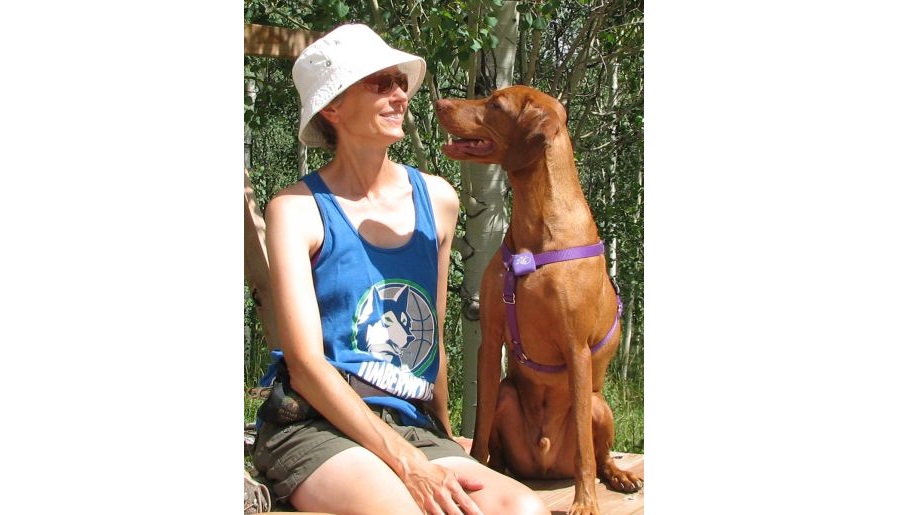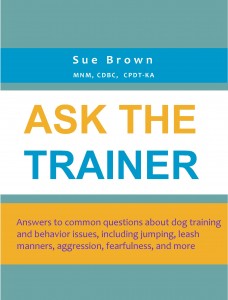An Interview With Sue Brown On Writing A Dog Training Book
Writing a book about dog training can help you to establish yourself as an industry authority in your community and beyond. But what does it take to write a book? We asked Sue Brown, an accomplished dog trainer and author of Juvenile Delinquent Dogs: The Complete Guide to Saving Your Sanity and Successfully Living with Your Adolescent Dog and Ask the Trainer to talk to us about her own experience as an author.
When it comes to dog training in Denver, Colorado, Sue Brown sets a standard of professionalism that serves as a model for the up-and-coming trainers in her community and makes her a trusted colleague of the more experienced trainers. She holds certifications through the International Association of Animal Behavior Consultants and the Certification Council for Professional Dog Trainers. She also is a Canine Good Citizen (CGC) evaluator, and is the co-founder of the Colorado Dog Trainers Network, a networking and training organization for Colorado dog trainers.
The Modern Dog Trainer: You have written two books, Juvenile Delinquent Dogs and Ask the Trainer. Why did you decide to write these books?
Sue Brown: I wanted to find a way to share my knowledge and experience with a wider audience. In addition, I had known I wanted to write a book for a long time. I enjoy writing and I wanted to do something more in-depth than you can do with a blog. The only thing holding me back was determining the right topics. Once I had an idea I was passionate about, I got started!
TMDT: Why did you choose those particular topics?
SB: I wanted to write a book that had not already been done several times over. As I scoured through the available books, I noticed there were tons of books about puppies and about dogs in general but none about adolescent dogs. And most books are written from the perspective of a “textbook” sort of approach. I wanted something different. My training clients have always appreciated the personal stories I shared about my own dogs, so I wanted to take on a new topic from the perspective of going through the process with my own dog. So I wrote Juvenile Delinquent Dogs as I was raising my Vizsla, Romeo. He gave me plenty of stories to share! As for Ask the Trainer, it was a way for me to compile and share the articles I had been writing for several years that cover a wide variety of topics.
TMDT: How long did it take you to write each of your books?
SB: The initial draft of Juvenile Delinquent Dogs took one-and-a-half to two years. That was due in part to the fact I was writing it as I was raising Romeo and I wanted to cover that entire process as it was fresh in my mind. In addition, my clients knew I was writing the book, so they kept giving me more ideas to add. The edits and re-writes added another several months.
Ask the Trainer was a compilation of articles I had written over time for a rescue group newsletter, so that was written in stages over several years.
TBDT: What was the most fulfilling thing about writing your books?
SB: I have always loved to read. As a child, I could sit and spend an entire afternoon reading a book from start to finish. So it was very fulfilling to see an actual book that I had written myself!
TBDT: What was the most difficult thing about writing your books?
SB: I had intended Juvenile Delinquent Dogs to be around 150-200 pages, but it ended up being much longer because there was so much I wanted to share. Even as a student, I always had trouble keeping my written essays short! The hardest part was deciding when to stop. I still think of things I wish I had been able to include. I am happy with the length of it, as it is intended to be a reference book for those living with dogs. I don’t expect people to read it cover to cover in one sitting. It’s meant to be kept handy so it can be referred to over and over again.
TBDT: How do you use your books to augment the dog training you do in your community?
SB: Some people who contact me cannot afford the training that would be most beneficial, so the books are a chance to gain a lot of information and have the ability to go back to it over and over again. Other people will participate in group classes or private training and buy the book to supplement our training together so that they can go back and take time to absorb what we have covered in person. Studies show that people will forget 90% of what they have heard within a week. The books are a way to have that information handy and be able to go back to it at any time.
TBDT: Why did you choose self-publication over traditional publication with a company like Dogwise?
SB: I love to learn, and being able to self-publish and handle that entire process myself was a great learning experience. I certainly made mistakes and would do some things differently next time around. But I am also a Type-A personality, and I knew I wanted control over the entire process. This was my “baby” and I wanted it to be exactly what I wanted!
TBDT: Your first book, Juvenile Delinquent Dogs is available in hard copy and e-book formats, and your second book, Ask the Trainer, is available only in e-book format. What were your reasons for those format selections?
SB: E-books are very popular now, and there are many benefits to them. But I still love being able to hold a book in my hands and carry it with me. So Juvenile Delinquent Dogs was always intended to have a print and e-book version to satisfy both types of people – those who still prefer to hold a book in their hands and those who prefer the economy and convenience of an e-book. For Ask the Trainer, I had seen everything it takes to produce a print version – and the expenses that go with it – and decided to stick with an e-book format for this book. This also gives me the option of easily revising it and adding new articles – which I have done several times already.
TBDT: What advice would you give to those who aspire to write their own books?
SB: My first piece of advice would be to choose a topic about which you are passionate. The process can be long and frustrating at times, so your passion will help you stick with it.
Next would be to talk to others who have done it so that you can avoid some of their mistakes. Also, be honest about how much time and effort you have to put into it. While I am glad I self-published, I honestly do not know if I would do that again. It took a long time and a ton of work, and I don’t know that I could put that much time into another book.
Finally, do not let doubts or anything else hold you back. If you’re passionate about it, go for it!
TMDT: You obviously have worked very hard on your professional certifications. Do you believe it is important for up-and-coming writers to hold dog training certifications?
SB: Our profession is unregulated, so it is very much a buyer-beware market. I believe independent certifications from reputable organizations are a way for us to begin setting standards, minimum qualifications and a set of ethics by which we all strive to abide. Many clients do not know to ask about qualifications, but I am seeing more and more who do. As it pertains to writers, I believe legitimate certifications help lend credibility and demonstrate a degree of expertise, especially for those whose names are not well-known.
TBDT: Can you give us a concise summary of your book-writing process?
SB: Yes, I do it like this:
- Outline your book. Consider what you will cover and how it will be laid out.
- Write it. Review it. Make revisions. Review it again. Make more revisions.
- Have a few people review it. I had 3-4 people review it for me and give feedback. Make revisions.
- Send it to an editor/proofreader. Make more revisions. Send back for re-review. Make more revisions.
- Send to a professional for layout and formatting.
- Determine your final title and design your book cover. Or work with someone to design it for you.
- Review it — and review it again — to ensure everything is perfect.
- Send it to printer.
- Don’t forget to work on your marketing during all of this as well!
- Figure out pricing. It will depend upon how much of this you do yourself and how much you pay others to do. If you are self-publishing, it is a lot more expensive because you are covering ALL of the costs, but you keep more of the profits as well. If you are working with a publisher, you share some costs, and you also receive a smaller percentage of sales.
TMDT: What is next in your book-writing career?
SB: I hope to get started on another book in 2015. You will have to wait to find out the topic!
If any of you have more questions for author Sue Brown, please let us know in the comments, and we will try to get them answered for you. We’d like to extend a BIG thank you to Sue for taking the time to answer our questions. Be sure to check out her books and ebooks!
Get Dog Training Business Tips!
Receive valuable dog training business tips and resources every week! Subscribe to The Modern Dog Trainer now by submitting your name and email below.
[mc4wp_form]






